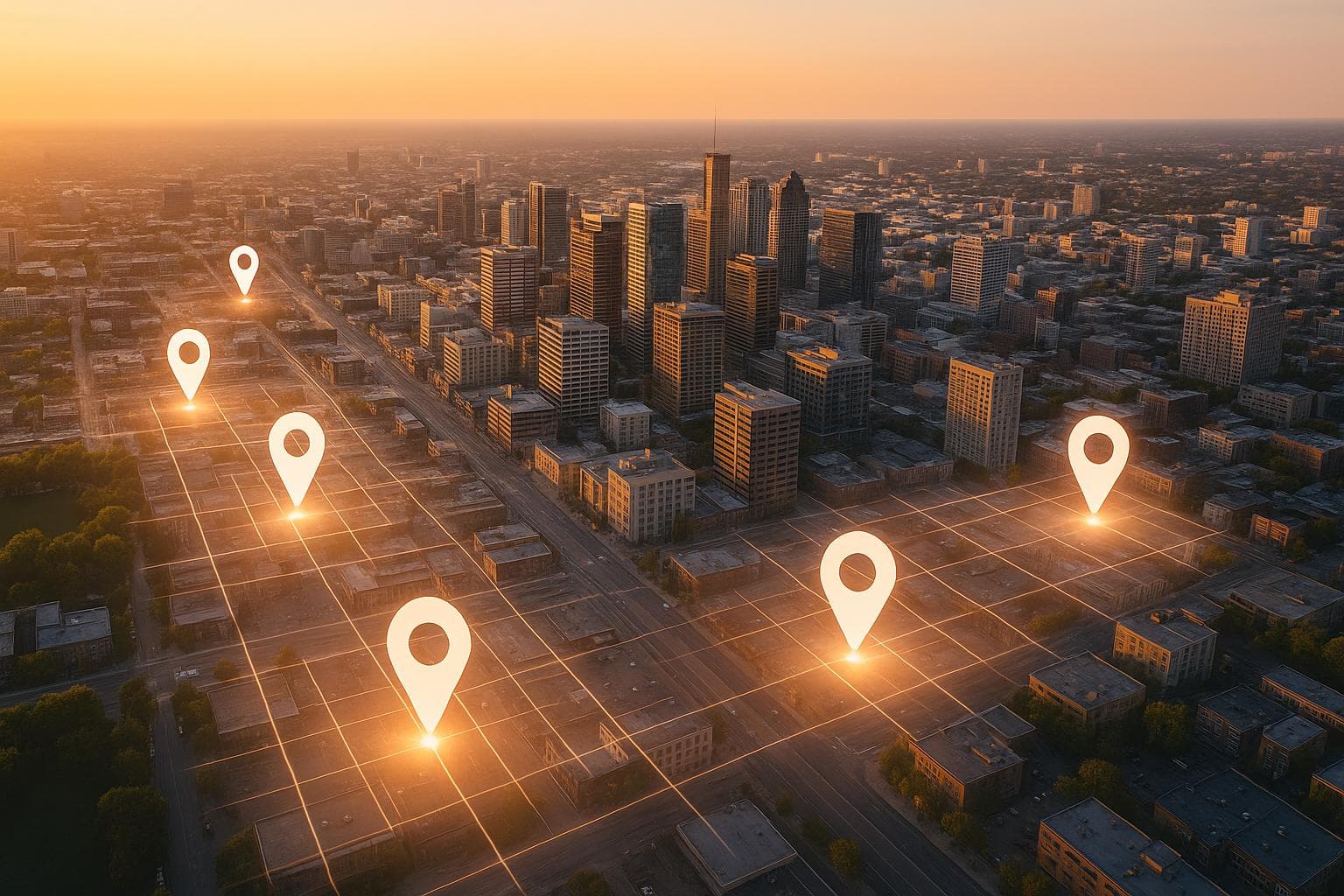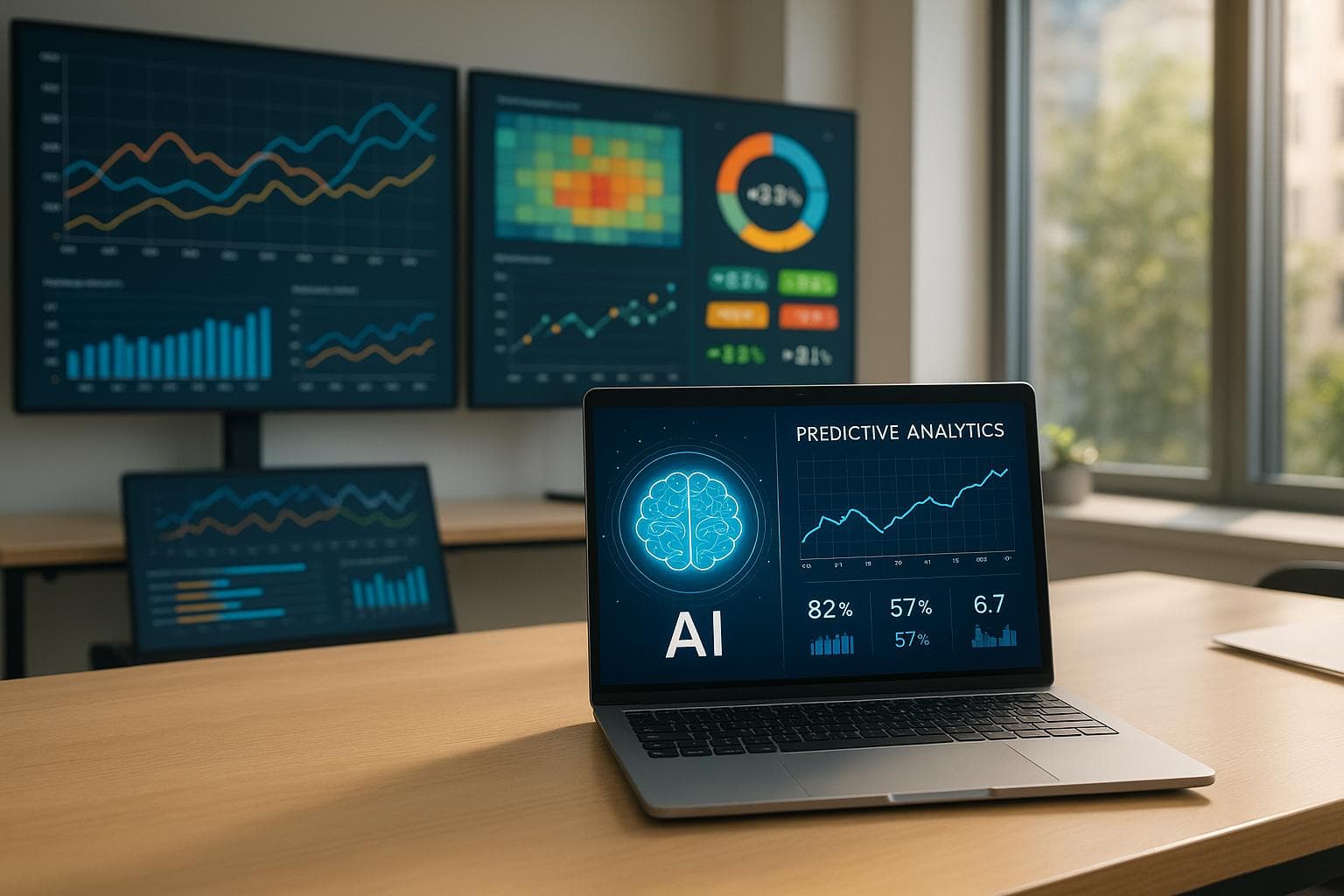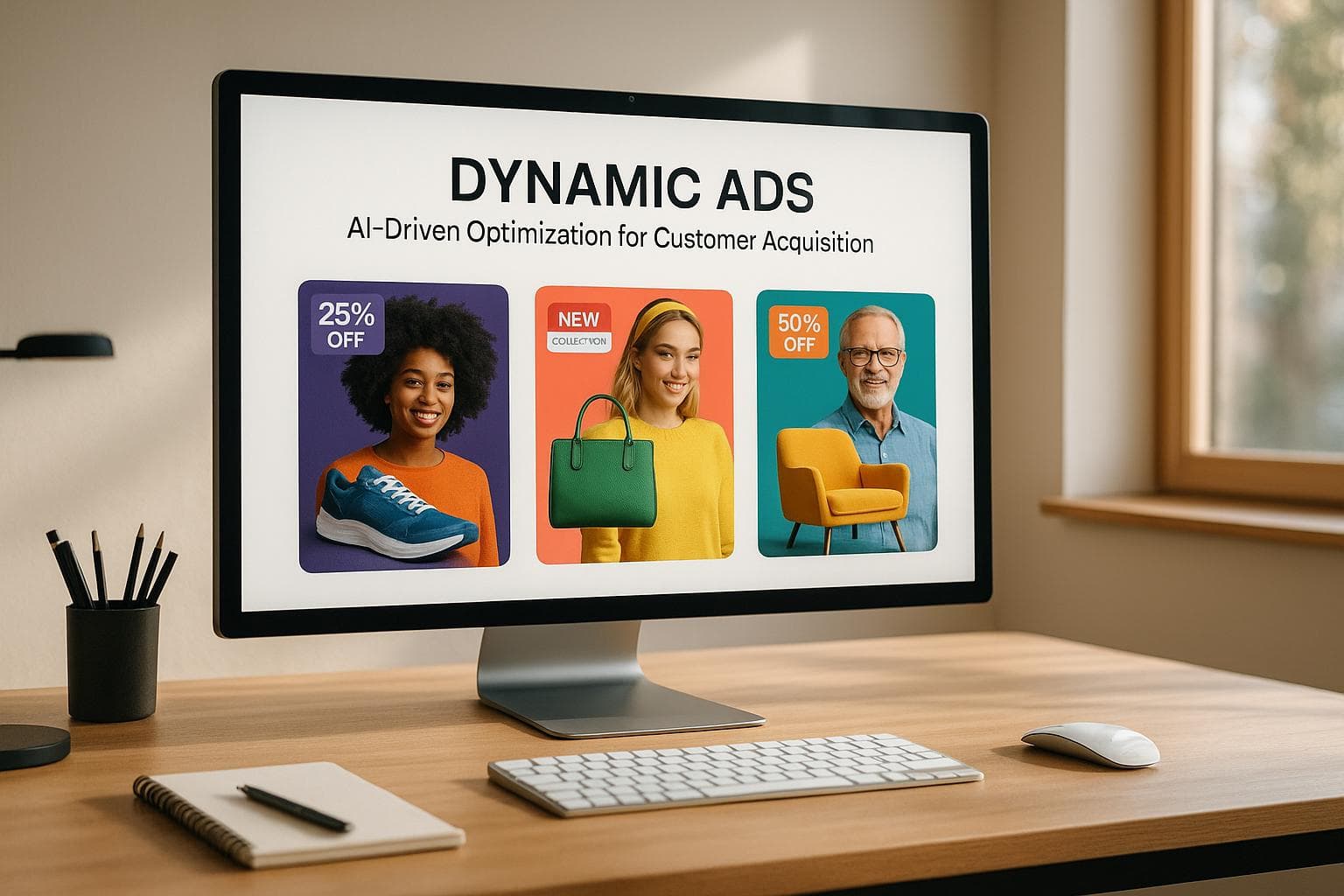How AI Improves Location-Based Ads
Explore how AI enhances location-based advertising through better targeting, accuracy, and real-time personalization while addressing privacy challenges.
Location-based ads are getting smarter, thanks to AI. Here's how:
- Better Targeting: AI uses real-time data, like your location, habits, and preferences, to send ads that feel personal and relevant.
- Improved Accuracy: AI fixes issues like GPS errors, ensuring ads reach the right people at the right time.
- Real-Time Personalization: Ads adjust instantly based on weather, events, or what you're doing, making them more useful.
- Privacy Safeguards: AI tools now comply with laws like CCPA, balancing effective targeting with data protection.
For example, AI can predict where you'll go next and send tailored offers, like a coffee discount during your morning commute. Businesses using AI-driven ads have seen a 22% boost in campaign performance.
AI isn't just making ads smarter - it's solving old problems like mistimed messages and wasted budgets.
Google Ads AI Max Locations of Interest
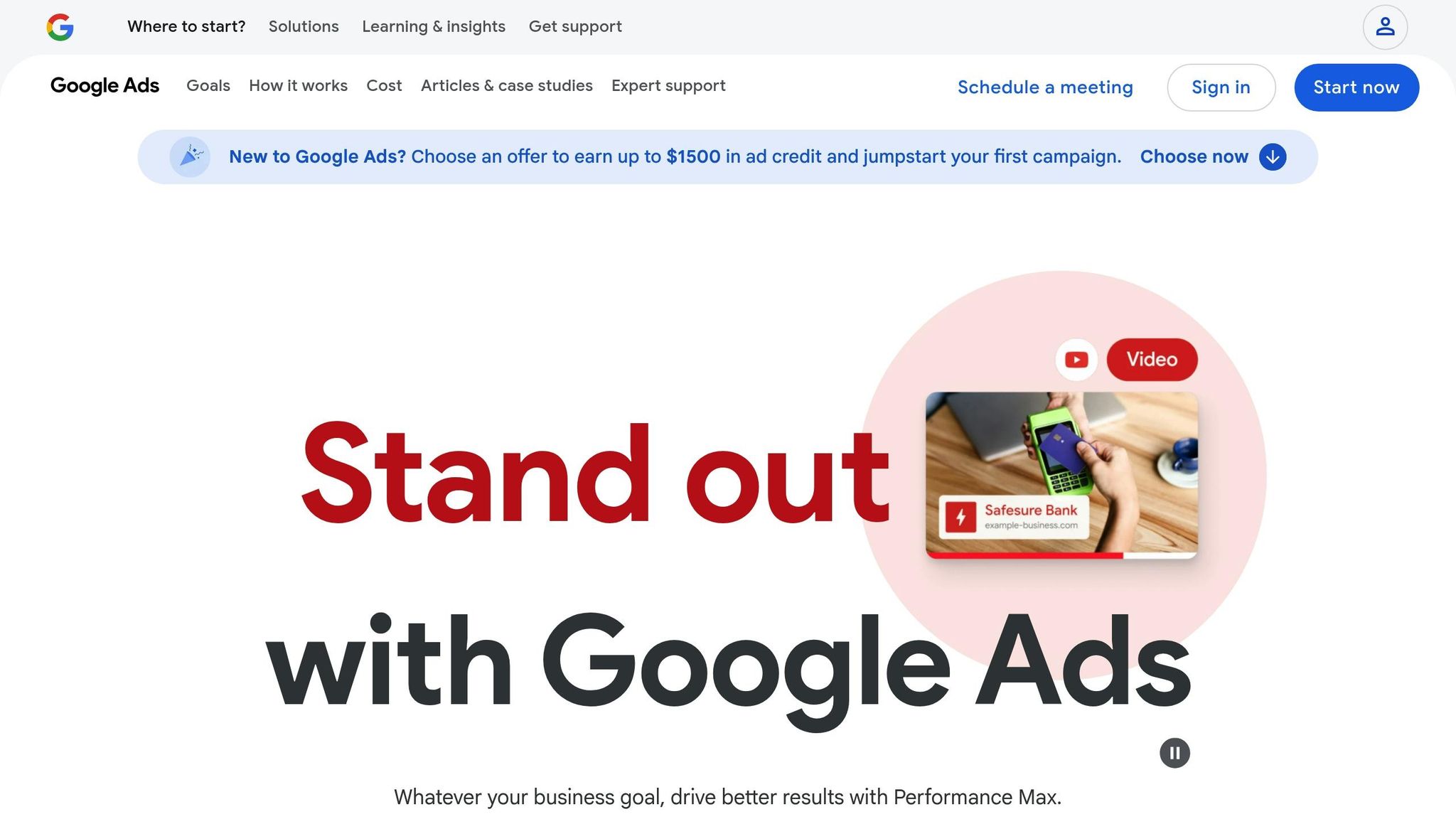
Problems with Location-Based Advertising
Location-based advertising comes with a set of challenges that can waste budgets and reduce its effectiveness. These hurdles have long frustrated marketers, making it harder to connect with customers at the right time and place.
Poor Data Accuracy
One of the biggest issues is unreliable data. Errors in GPS or outdated location databases often result in ads being shown to people outside the intended area, wasting as much as 30% of ad budgets. For example, GPS signals can be inaccurate by several meters - or even miles - especially in cities where tall buildings disrupt satellite communication. Imagine a coffee shop trying to attract nearby customers but instead reaching someone blocks away. That’s a lot of wasted effort.
Wi-Fi and cell tower triangulation aren’t much better. In dense urban areas or rural spots with weak signals, these methods only provide rough location estimates[4][8]. A restaurant hoping to target office workers during lunch might end up advertising to people far from their location.
Industry estimates show that such inaccuracies can directly impact return on investment, making businesses question whether their ad spend is worth it[7].
Privacy Issues
Privacy concerns are another major roadblock. About 68% of consumers worry their location data could be misused[6]. After all, tracking someone’s location can reveal sensitive details about their daily routines, workplaces, and even personal relationships.
Laws like the California Consumer Privacy Act (CCPA) aim to address these concerns by requiring clear opt-out options and transparency about how data is used[1][2]. However, for many consumers, the complexity of AI-driven profiling leaves them unsure about how their information is being processed.
This lack of trust can hurt brands. A 2022 survey found that 54% of consumers are more likely to avoid companies they feel mishandle their data[6]. The problem becomes even more serious with AI systems that can infer private details from location patterns, potentially exposing aspects of people’s lives they’d rather keep private.
Wrong Timing and Context
Even when location data is accurate, timing and context can ruin an ad’s effectiveness. For instance, a flash sale notification that arrives five minutes after someone has already passed the store is essentially useless.
Contextual missteps are another common issue. Ads for lunch deals sent after the lunch hour or promotions for outdoor events during bad weather can appear clueless and irrelevant[1][4]. Without real-time awareness of local conditions, these ads miss the mark entirely.
Another layer of complexity is understanding the user’s mindset. Someone rushing to catch a train isn’t likely to stop for shopping, no matter how close they are to a store. Similarly, showing entertainment offers to someone focused on work during business hours is unlikely to succeed.
These poorly timed or irrelevant ads don’t just waste money - they can actively harm a brand’s reputation. People expect brands to understand their needs and respect their time. When ads feel intrusive or out of touch, they leave a lasting negative impression.
| Problem Area | Impact on Campaigns | Common Consequences |
|---|---|---|
| Poor Data Accuracy | 30% wasted ad spend | Wrong audience targeting, low engagement |
| Privacy Concerns | 54% brand avoidance risk | Reduced opt-in rates, compliance costs |
| Wrong Timing/Context | Low conversion rates | Negative brand perception, missed opportunities |
Overcoming these challenges will require smarter, more precise tools that can improve accuracy, respect privacy, and deliver messages that truly resonate with the audience’s situation.
How AI Fixes Location-Based Advertising Problems
AI is reshaping location-based advertising by addressing long-standing challenges in precision, targeting, and personalization. By replacing broad, guesswork-driven strategies with intelligent, data-driven solutions, AI ensures campaigns are more accurate, relevant, and effective. Let’s dive into how AI improves data accuracy, local targeting, and real-time personalization.
Better Accuracy with Predictive Analytics
AI-powered predictive analytics takes location data accuracy to the next level by analyzing a variety of data sources simultaneously. These systems process real-time location signals, historical trends, and even external factors like weather and traffic patterns to create a clear picture of customer behavior[1].
Instead of relying on outdated demographic targeting, AI uses micro-segmentation to craft detailed customer profiles. Machine learning models analyze individual preferences, purchase history, movement patterns, and even time-of-day habits to predict customer needs[1].
In fact, in 2024, brands that adopted AI-driven location intelligence saw a 22% improvement in marketing campaign performance[1]. This is because AI doesn’t just identify where customers are - it predicts where they’re headed and what they’ll likely need. For instance, AI can recognize regular morning commuters and send timely promotions just before they pass a nearby store, reducing wasted ad spend.
AI also enhances physical targeting by leveraging tools like geofencing and beacon technology, making targeting even more precise.
Precise Local Targeting with Geofencing and Beacons
AI enhances the effectiveness of geofencing and beacon technologies by making them smarter and more personalized. These tools allow businesses to target users with tailored messages when they enter specific areas, driving engagement and foot traffic into stores[2]. Unlike traditional geofencing, which sends generic messages to everyone, AI ensures the right message reaches the right person at the right time.
For example, AI-powered geofencing can send a tailored discount offer when a customer crosses a specific boundary. By analyzing customer data, AI ensures the promotion aligns with the individual’s preferences and timing.
Modern platforms now support up to 100 geofence zones per campaign[7], enabling businesses to target customers with incredible precision. AI fine-tunes these zones with custom boundaries, ensuring ads reach people most likely to engage rather than blanketing an entire area[3].
Beacon technology takes this a step further by enabling hyper-local targeting within stores. When paired with AI, beacons can deliver promotions based on a customer’s exact location, shopping habits, and even the time they typically spend browsing. For instance, a customer lingering near the electronics section might receive a discount on headphones they’ve previously searched for online.
Real-Time Personalization
AI’s ability to deliver real-time, location-specific personalization transforms how customers experience advertising. By dynamically adjusting messages based on factors like location, weather, traffic, and behavior, AI drives higher engagement and conversions[1].
This approach works. Studies reveal 80% of customers are more likely to buy when offered personalized experiences, and companies focusing on personalization enjoy 40% higher revenue compared to those that don’t[1].
Real-time personalization adapts ad content and timing instantly. For instance, if a customer is near a store during lunch hours and has a history of buying salads, AI can serve them an ad for a lunch special that fits their preferences - all within milliseconds.
AI also goes beyond basic location data by analyzing environmental factors. On cold mornings, it might suggest hot coffee, while on scorching days, it promotes iced drinks. Even traffic patterns are considered - AI can detect if someone is stuck in congestion and offer nearby alternatives to make their day easier.
By turning generic ads into contextually relevant experiences, AI ensures promotions feel helpful rather than intrusive. Instead of bombarding everyone near a store with the same message, it tailors ads to each individual’s unique situation and preferences.
| AI Solution | Key Benefit | Performance Impact |
|---|---|---|
| Predictive Analytics | Individual-focused targeting | 22% campaign performance boost |
| AI-Powered Geofencing | Precise local engagement | 100 distinct targeting zones |
| Real-Time Personalization | Contextual relevance | 80% higher purchase likelihood |
sbb-itb-0bd1697
How to Use AI-Powered Location-Based Ads
Diving into AI-powered location-based advertising doesn’t have to feel like a monumental task. The trick lies in selecting the right tools, tailoring content to specific audiences, and keeping a close eye on your results. Here’s how businesses can make these strategies work.
Using AI Tools and Platforms
Start by picking an AI-driven platform that simplifies managing all your ad accounts. A tool like Feedcast.ai is a great example - it consolidates platforms like Google, Meta, and Microsoft Ads into one dashboard. This setup minimizes manual errors and makes it easier to handle campaigns across multiple locations.
The process typically starts with defining your geographic targeting (like specific cities or custom radius zones), importing your product or service data, and setting up geofencing triggers for real-time engagement. Many AI platforms let you manage multiple geofencing zones within a single campaign, giving you the flexibility to target everything from small local stores to sprawling urban areas. This streamlined approach has already proven effective for boosting local engagement.
Creating Content for Location and Context
Once your platform is ready, the next priority is crafting content that connects with your audience on a local level. AI makes this easier by turning data into actionable insights. By analyzing consumer behavior, preferences, and purchase history, you can create hyper-targeted messaging that resonates with each market.
Take the example of a Miami real estate agency in June 2023. They used AI tools to identify popular local search terms like "oceanfront properties" and "condos in Miami Beach." By incorporating these keywords into their campaigns, they saw a 27% jump in qualified leads in just three months[5].
AI also helps fine-tune content based on external factors. It can adjust messaging to align with local events, weather conditions, or even the time of day. For instance, a coffee shop might promote iced drinks during a heatwave but switch to hot beverages on cooler mornings. Testing different localized creatives and tracking their performance is essential to refining your strategy for each region.
Measuring Performance and Improving Results
AI’s ability to target precisely and personalize in real time is only half the story - you also need to measure performance to keep improving. AI-powered analytics provide real-time insights, moving beyond static reports to help you optimize quickly.
Keep an eye on metrics like click-through rates by location, conversion rates, foot traffic increases, and return on ad spend (ROAS). AI platforms can break down performance by region, time, and audience, helping you pinpoint which areas are performing well and which need adjustments.
Machine learning takes this a step further by predicting which locations or audiences are most likely to convert. This allows you to dynamically tweak your targeting, messaging, and budget allocation. For example, Feedcast.ai’s unified dashboard lets businesses monitor performance across all channels in one place, making it easier to spot trends and reallocate resources to high-performing areas. This data-driven approach consistently leads to better ROI and more efficient campaigns.
| Step | Key Actions | Expected Results |
|---|---|---|
| Select a Platform | Consolidate ad accounts; set geofencing zones | Easier campaign management |
| Create Content | Use local data; craft tailored messaging | 27% boost in qualified leads |
| Track Performance | Analyze metrics; adjust in real time | Higher ROI and improved effectiveness |
Future of AI-Powered Location-Based Advertising
As data accuracy improves and real-time personalization becomes the norm, location-based advertising is entering an exciting new phase. Emerging technologies are reshaping how brands connect with consumers, with three key trends leading the charge: the fusion of augmented reality (AR) and artificial intelligence (AI), the widespread rollout of 5G networks, and a stronger emphasis on ethical data practices. Together, these advancements are redefining customer engagement and how businesses operate.
Augmented Reality and AI Integration
Augmented reality and AI are teaming up to create more immersive advertising experiences. Instead of limiting ads to screens, brands can now overlay digital content onto real-world environments. AI analyzes a person’s location, behavior, and preferences to deliver AR content at just the right moment. Picture this: as you walk past a coffee shop, your phone displays a virtual promotion for your favorite drink, complete with a personalized discount.
Starbucks is already exploring this concept with AI-driven, location-triggered AR campaigns designed to boost customer loyalty and sales[1][4]. These interactive encounters are not just memorable - they’re effective. Research shows that AR-powered ads often achieve higher engagement and better brand recall compared to traditional digital formats[9]. With 5G technology expanding connectivity, these experiences are becoming even more seamless.
5G and Better Connectivity
The arrival of 5G is removing the technical hurdles that once held location-based advertising back. Faster data speeds, reduced latency, and more reliable connections allow brands to deliver high-quality, real-time content[6][9]. Imagine strolling through a shopping district and instantly receiving a video ad tailored to your location and shopping history. Thanks to 5G, these ads load instantly and feature dynamic elements like interactive product demos or 3D models.
This next-generation connectivity also enhances geofencing capabilities, enabling brands to target consumers with pinpoint precision. Whether it’s an AR-driven experience or a personalized recommendation, 5G ensures that ads are delivered at the perfect time and place. However, these technological leaps come with an added responsibility to address privacy concerns.
Ethics and Privacy Considerations
As location-based advertising grows more sophisticated, ethical data practices have become increasingly important. These technologies rely on collecting sensitive information, such as geospatial and behavioral data, which raises questions about how this data is gathered and used[6]. Regulations like the California Consumer Privacy Act (CCPA) are pushing companies to adopt transparent data practices[1]. Beyond compliance, being transparent builds trust - a crucial factor in maintaining strong customer relationships.
To navigate this landscape, businesses need to implement robust privacy controls, regularly update consent mechanisms, and train their teams on responsible AI use. Feedcast.ai is one example of a company integrating privacy-compliant features into its AI tools. Their approach combines advanced targeting capabilities with safeguards to ensure location data is handled responsibly. By prioritizing both innovation and privacy, businesses can create personalized advertising experiences while earning consumer trust. The future of location-based advertising belongs to those who can strike this balance.
Conclusion
Looking at the challenges of location-based advertising and how AI addresses them, one thing becomes clear: success lies in precision and personalization. AI has transformed what was once a hit-or-miss approach into a data-driven powerhouse, helping businesses connect with customers in the right place at the right time.
Key Takeaways for Businesses
Companies that integrate AI into their location-based advertising strategies are seeing real results. For instance, businesses using AI-driven location intelligence have reported a 22% increase in campaign performance, while 80% of consumers are more likely to make a purchase when offers are personalized. Additionally, businesses that prioritize personalization enjoy 40% higher revenue[1].
AI tackles major hurdles by improving data accuracy, safeguarding privacy, and using predictive analytics to time messages effectively. These advancements allow for hyper-local personalization, content that adapts dynamically, and micro-segmentation to target customers more precisely. Leading brands have already demonstrated how AI can elevate hyper-local targeting, proving the practical value of these cutting-edge methods.
Feedcast.ai takes these benefits a step further by making sophisticated AI tools easy to use.
How Feedcast.ai Supports Businesses
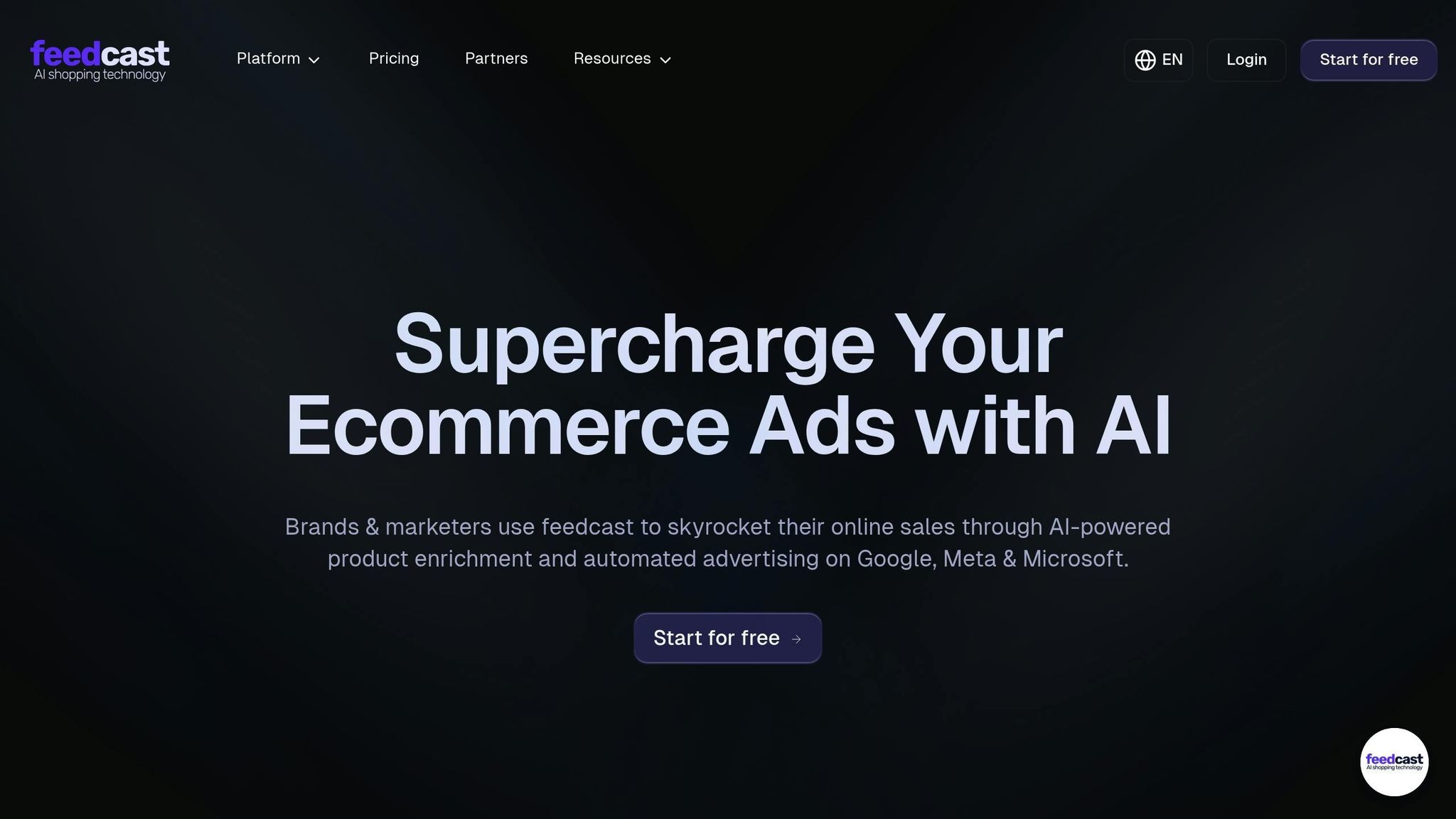
Feedcast.ai simplifies the complexities of multi-channel campaigns by offering a single dashboard to manage everything. From automating ad creation to providing real-time performance analytics, the platform’s AI-driven tools make location-based advertising more efficient.
By enriching product data with location-specific keywords, Feedcast.ai helps businesses improve their visibility in local searches. Its smart targeting features leverage geographic and behavioral data to reach the right audience, while detailed analytics ensure campaigns can be fine-tuned for better results. With flexible subscription plans - ranging from a free tier to enterprise solutions - Feedcast.ai makes these advanced tools accessible to businesses of all sizes.
As location-based advertising evolves, AI will remain at the forefront, driving smarter, more personalized, and highly effective customer engagement.
FAQs
How does AI enhance the accuracy of location data for advertising campaigns?
AI plays a pivotal role in refining location data for advertising, ensuring campaigns reach their intended audience with precision. By processing massive datasets and uncovering patterns, AI can validate and enhance location details by cross-referencing sources like GPS signals, user activity, and location histories.
With this level of accuracy, businesses can serve ads to the right people at the most opportune moments, boosting relevance and engagement. This approach not only minimizes errors and reduces wasted ad budgets but also allows advertisers to craft highly personalized, location-focused campaigns that truly resonate with their audience.
How does AI ensure consumer privacy in location-based advertising?
AI-driven location-based advertising takes consumer privacy seriously by complying with stringent data protection laws like GDPR and CCPA. To further safeguard user information, these systems employ advanced anonymization methods, ensuring personal data is handled securely and that details such as precise locations are only shared with proper consent.
Moreover, many AI systems rely on aggregated and de-identified data. This approach reduces the chances of exposing individual information while still delivering tailored and impactful advertising experiences.
How can businesses use AI tools to improve their location-based advertising?
AI tools have the power to transform location-based advertising by refining product data and crafting campaigns that zero in on specific audiences. For example, AI can process customer behavior and location insights to serve tailored ads to the right people at the perfect moment.
Platforms such as Feedcast make this process seamless. They automate ad creation, boost product visibility using AI-enhanced data, and enable more precise targeting strategies. These capabilities allow businesses to expand their audience reach and achieve better results across various advertising channels.
Geoffrey G.
